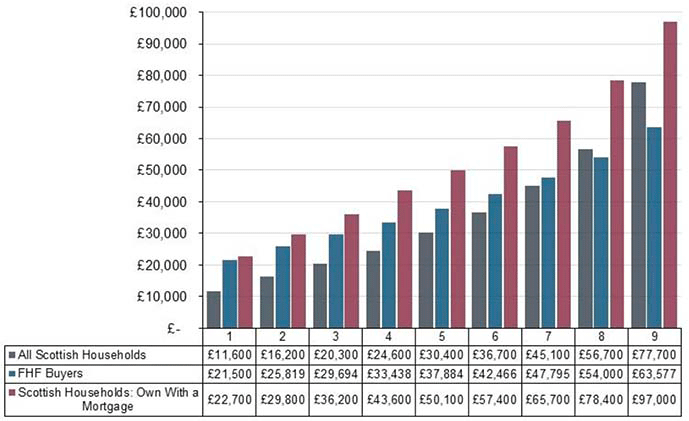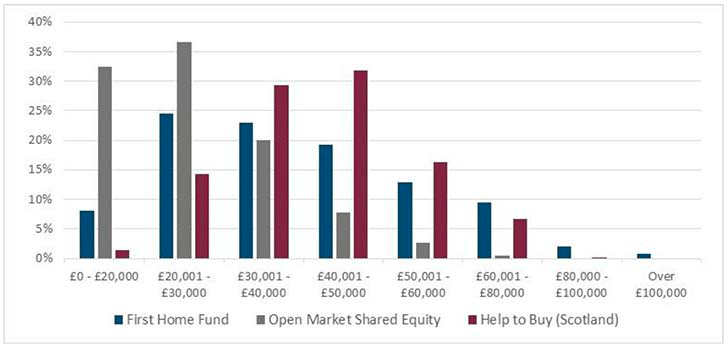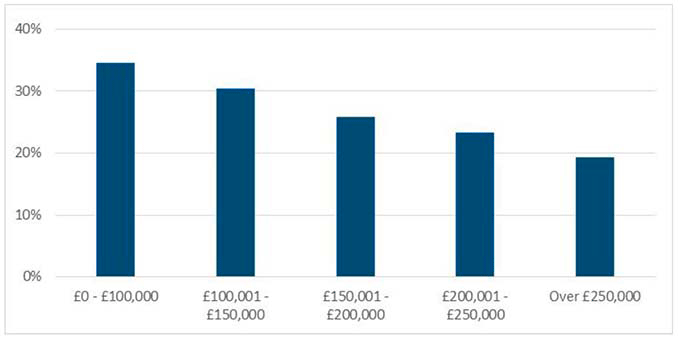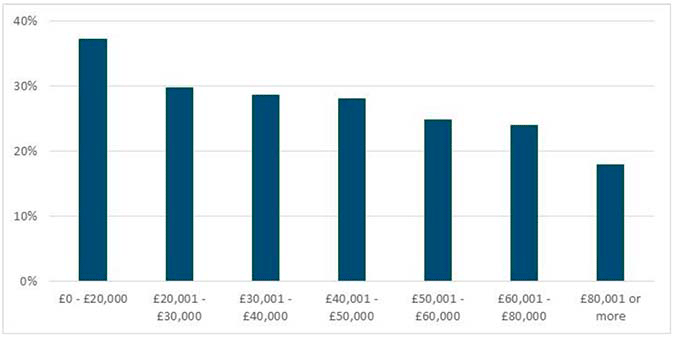First Home Fund - quantitative and qualitative analysis: evaluation synthesis
Summary of findings from the quantitative and qualitative evaluations of the First Home Fund.
Key Findings
Characteristics of FHF buyers
FHF buyers are relatively similar to all first-time buyers across Scotland. The average age of FHF buyers (30.4) is similar to the average age of all first-time buyers in Scotland in 2019-20 (31.0).

The average gross annual household income of FHF buyers (£40,900) is similar to average gross annual household income of all first-time buyers in Scotland in 2019-20 (£40,800). However, FHF buyers are not typically on low to moderate incomes when compared to the Scottish population: nearly seven in ten (68%) FHF buyers have gross annual household income equal to or greater than £30,400 – the median gross annual household income of all Scottish households in 2018-19.

Source: Income data for all Scottish households and all Scottish households who own their home with a mortgage is for 2018-19, and is taken from Scottish Government analysis of data from the Family Resources Survey Households Below Average Income dataset (rounded to the nearest £100).
Gross annual household earnings[7] are typically significantly higher in the FHF than in the Open Market Shared Equity scheme, and, while average FHF earnings is slightly below Help to Buy (Scotland) average earnings, there is a greater spread of earnings in the FHF. Average household earnings of FHF buyers (£40,400) is more than 50% higher than average earnings of buyers through the Scottish Government's main other first-time buyer scheme, Open Market Shared Equity (£26,200 in 2019-20). While average FHF buyer earnings is slightly below average Help to Buy buyer average earnings (£42,000 in 2019-20), Figure 3 shows that the spread of earnings in the FHF is greater than in Help to Buy: 33% of FHF households have earnings below £30,000 compared to 16% of Help to Buy households, while 12% of FHF households have earnings over £60,000 compared to 7% for Help to Buy households.

Some FHF buyers (5%) have previously owned property. Compared to other buyers, these buyers tend to have higher household income, purchase more expensive properties, and claim more funding through the FHF. In interviews, the appropriateness of only one of those making a joint purchase needing to be a first-time buyer was queried; the suggestion was that if one of a couple has already got over the first hurdle to home ownership, most obviously in terms of having got together a sufficient deposit, then there is no obvious reason for their second purchase to be eligible for a first-time buyer scheme.
The previous tenure of FHF buyers was largely renting (mainly privately) or living with parents or relatives. Approximately half (50.4%) of FHF buyers were previously living in rented accommodation, with the split between private and social renting approximately three quarters to one quarter (with a very small number living in employer-provided accommodation). Just under half (46.0%) were living with parents or relatives. A small share (2.1%) were living in property they owned outright or were paying a mortgage on, while the remainder (1.5%) were living with friends (where they were not renting). A small proportion (6%) of FHF buyers were on a social housing waiting list prior to purchasing their home through the FHF.
Types of properties bought through the FHF
The FHF was used widely across Scotland and property types. It has been used particularly intensively in larger cities, and in urban local authorities that have substantial rural areas, relative to islands and remote areas. Approximately 17% of properties purchased through the FHF are new builds, relative to the share of new build sales in all Scottish residential property transactions of 12% in 2019-20. Flats are the most commonly purchased property type through the FHF.
Properties purchased through the FHF are typically more expensive than the average first-time buyer purchase price across Scotland, with the majority of FHF buyers using it to buy a larger property than would otherwise have been the case. The average price of a property purchased through the FHF (£147,600) is higher than the average first-time buyer price across Scotland (£124,000), but lower than the average purchase price for all buyer types across Scotland (£153,500). This conclusion is robust to geographic compositional effects, as well as adjusting for the relatively high share of new build properties purchased through the FHF. Just over six in ten (63%) of new build properties purchased through the FHF had a price in excess of £200,000, the price cap for Help to Buy (Scotland). Nearly two-thirds (63.9%) of FHF buyers reported that the scheme had enabled them to buy a larger property.
| Existing Build | New Build | All | ||||
|---|---|---|---|---|---|---|
| Price Band | Number | Percent | Number | Percent | Number | Percent |
| £0 to £49,999 | 14 | 0.2% | 0 | 0.0% | 14 | 0.1% |
| £50,000 to £99,999 | 1,640 | 20.3% | 2 | 0.1% | 1,642 | 16.9% |
| £100,000 to £149,999 | 2,978 | 36.8% | 119 | 7.3% | 3,097 | 31.8% |
| £150,000 to £199,999 | 2,155 | 26.6% | 471 | 28.7% | 2,626 | 27.0% |
| £200,000 to £249,999 | 950 | 11.7% | 685 | 41.7% | 1,635 | 16.8% |
| £250,000 to £299,999 | 252 | 3.1% | 279 | 17.0% | 531 | 5.5% |
| £300,000 to £349,999 | 64 | 0.8% | 59 | 3.6% | 123 | 1.3% |
| £350,000 or more | 35 | 0.4% | 26 | 1.6% | 61 | 0.6% |
| Total | 8,088 | 100% | 1,641 | 100% | 9,729 | 100% |
User satisfaction with scheme
Although buyers would prefer to purchase the same house without accessing a shared equity scheme, it was seen as a good, pragmatic choice, in particular if it made it possible to buy in areas to which they had connections but might otherwise not be able to afford. All lenders, developers and independent financial advisors interviewed were supportive of Government-led policies which enabled first-time buyers to overcome difficulties in saving for a deposit.
The vast majority of FHF buyers reported that they were able to purchase a property that met their needs and was located in an area that they want to live in. FHF buyers were asked whether they agreed or disagreed with the following statements (set out in Table 2) about the property and area it was located in, reporting high levels of satisfaction.
| Statement | Number of Responses | Share of Respondents That Agreed |
|---|---|---|
| The property is the right size for my current housing needs | 6,704 | 98% |
| I have been able to buy the type of property that I was looking to purchase (e.g. new build/existing build, detached, semi-detached, terraced or flat) | 6,690 | 97% |
| The property is affordable for my budget | 6,707 | 98% |
| The property is in a location that I want to live in | 6,722 | 97% |
Some FHF buyers who were interviewed reported that the impact of becoming a homeowner had been life-changing. For some living in the private rented sector, it has enabled them to move on from living in shared, overcrowded, or other unsuitable housing. Those in their mid-thirties or older, as well as those with children, were particularly likely to emphasise the sense of security, permanence and improved wellbeing that had come with owning a home.
The simplicity of the scheme was welcomed by users. For many, one of the key strengths of the First Home Fund is its flexibility in terms of the limited restrictions on the age, type (in particular not being restricted to new build) and size of property that can be bought and the relatively straightforward eligibility criteria and application processes. The absence of a price cap was seen as opening up the opportunity for first-time buyers to buy a larger family home, and also a new build above the £200,000 Help to Buy (Scotland) cap. The absence of means testing was seen as eliminating one of the more confusing elements of other schemes. All interviewed lenders said the decision to offer a FHF-compatible mortgage product had been a relatively easy and straightforward one.
The flexibility to offer over valuation was seen as a strength, particularly for those trying to buy in areas with buoyant housing markets where properties routinely sell over Home Report valuation. Nearly four in ten (39.0%) FHF buyers purchased a property at a price above valuation and, on average, paid 4.2% above the valuation of the property. In aggregate, the average FHF price was 0.6% above valuation. This suggests the FHF rules strike a good balance by tempering the flexibility to bid over valuation with the requirements that this is cash funded and that the Scottish Government equity share is calculated relative to the lower of the valuation or the purchase price, which helps to protect the public purse.
Buyers were generally accepting of an application fee being payable and of that fee being set at £550, while other stakeholders also felt the application fee presented few issues.
Scottish Government communication about the FHF was reported as good, although there were some caveats. Professional stakeholders generally reported that Scottish Government communication about the FHF had been good; however, the experience of developers was more mixed, with a view that the launch of the FHF was not as well organised as had been the case for other Scottish Government shared equity schemes, and there was a general observation that the FHF had not been well-publicised and prospective buyers were only likely to have known about it if they had actively sought out information on funding a first home purchase.
Deposit and funding
There was strong support by scheme participants for the maximum equity stake taken by the Scottish Government being set at £25,000. This was generally seen to be appropriately pitched at a level suitable for a substantial majority of first-time buyers in Scotland.
The majority (58.1%) of FHF buyers believed the FHF had enabled them to use less of their savings for their deposit; they also typically make a lower deposit contribution than the average first-time buyer across Scotland, and requested most of the funding available from the FHF. The mean FHF buyer's deposit contribution is £14,400; this is half the average first-time buyer deposit across Scotland in the year to end September 2020, which was £28,700. The majority of FHF buyers (52.8%) requested the maximum FHF equity loan amount of £25,000, while just over three in four (76.7%) buyers requested an FHF equity loan amount equal to £20,000 or more.
The mean Loan to Value (LTV) and Loan to Income (LTI) ratios of properties purchased through the FHF are broadly similar to the mean LTV and LTI ratios of all first-time buyers in Scotland. The mean LTV ratio of FHF properties FHF is 76.5%, compared with a mean LTV ratio for all mortgages advanced to first-time buyers in Scotland of 80.8% in the year to end September 2020 and 78.3% in Q3 2020. Meanwhile, the mean LTI ratio of FHF properties is 3.1 – the same as the mean LTI ratio for all first-time buyer mortgages advanced in Scotland in the year to end Q3 2020.
Housing market impact of FHF
The housing market impact of the FHF was assessed in two ways. The share of FHF buyers who would not have been able to enter the housing market at all was estimated. A limitation of this assessment, and of the findings reported above, is that it focuses on the beneficiaries of the scheme, and it is possible that other potential buyers were disadvantaged by being outbid by FHF buyers. By their nature, these other buyers are difficult to identify. Therefore wider housing market data was examined to test whether those FHF buyers who entered the housing market displaced other potential buyers.
Just under three in ten (28.2%) FHF buyers did not believe they could have purchased a property that would have met their needs without the FHF. The rate of additionality generated by the FHF, defined as those buyers who believed they could not have purchased a property that would meet their needs without the FHF, was estimated following a similar approach to that taken in other shared equity scheme evaluations, although it should be noted that a drawback of this approach is that households' assessment of their needs is inherently subjective; for example, a household with a higher income may have a higher expectation of what property will meet their needs than a household on a lower income. Those FHF buyers who said that they could not have bought any one of the following four types of properties without FHF assistance were assessed as additional:
1) the same property
2) a different property that would meet their needs in the same area
3) a different property that would meet their needs in a different area
4) a smaller property, or a property in need of more work, that would have still met their needs.
The estimated rate of additionality is generally lower for higher household incomes, and for higher purchase prices. Figure 4 shows that the additionality rate declines as the purchase price increases, from 35% for purchase prices up to £100,000 to 19% for purchase prices over £250,000. Figure 5 shows that additionality rate also generally falls as income rises, from 37% for households with income below £20,000 to 18% for households with income over £80,000. The additionality rate also tends to be higher for older households, with households over 30 having an additionality rate of 34% compared to 25% for households aged 30 and under. The additionality rate is also higher for households who have not previously owned a property (29%) than for households where one of the joint buyers has previously owned property (20%).


The finding that additionality is less than a third is supported by other evidence. That average income, LTV and LTI ratios of FHF buyers are similar to those of the average first-time buyer across Scotland, and the average price of a property purchased through the FHF is greater than the average price of a property purchased by all first-time buyers across Scotland, suggests that marginal first-time buyers struggling to access home ownership do not form the majority of FHF buyers. This is also consistent with the finding that a majority of FHF buyers reported that the scheme had enabled them to buy a larger property and use less of their savings for their deposit.
Where buyers are additional, this generally took the form of accelerating their entry to the housing market, although some may have struggled to enter the housing market at all. Approximately half (50.9%) of all (not just additional) FHF buyers believed it would have taken them at least two more years to have purchased the same property without the FHF. Buyers tended to say that in the absence of support, they would have continued to save until such time as they could afford to buy their preferred type of property or in their preferred location. However, just over one in ten (13.5%) believed it would have taken them more than five years to purchase the same property without the FHF. Of this latter group, there are likely to be some who might have struggled to save a sufficient amount not just to buy the same property but any property that meets their needs within a reasonable timescale.
The rate of additionality generated by the FHF is lower than other Scottish Government first time-buyer schemes, but higher than Help to Buy (Scotland). The estimated rate of additionality of 28% for the FHF is significantly below the rate of additionality of the Open Market Shared Equity scheme (47%), as well as the New Supply Shared Equity scheme (39%), which are the Scottish Government's other first-time buyer schemes, but above the rate of additionality of Help to Buy (Scotland) (20%), which is open to first-time buyers and home movers.[8] The lower rate of additionality for the FHF relative to other Scottish Government first-time buyer schemes is likely to be due to the lack of targeting; this is the flip side of the benefits of the scheme due to its simplicity.
Wider housing market evidence does not as yet suggest that the FHF has put significant upward pressure on first-time buyer prices, but it also does not suggest that the FHF has led to a marked increase in first-time buyer activity. Trends in first-time buyer prices and transactions in Scotland were compared to trends in the home mover sector in Scotland and also to trends across the UK. These comparisons should be treated with caution due to limited data given lags in the publication of aggregate data, but at this stage do not suggest a significant impact of the FHF on either prices or activity at the Scotland level.
The evidence suggests that the impact of the Covid-19 may have led to some increase in the rate of additionality of the FHF. The impact of Covid-19 on the economy and the housing market from March 2020 led to a decrease in the availability and increase in the interest rates on high-LTV mortgage products, which are typically important for first-time buyers, although lending conditions have subsequently began to improve. Some buyers who were interviewed had not planned to use the FHF, but decided to access it following the reduction in high-LTV lending. This may explain an increase in the additionality rate of 25% for applications submitted to the FHF from 18 December 2019 to 31 March 2020, to 29% from 1 April 2020 to 2 October 2020, although the increase is relatively small.
The FHF is likely to have diverted some sales from other Scottish Government shared equity schemes. While there are limitations on the quantitative and qualitative evidence available for analysing this issue, indicative estimates suggest nearly four in ten (37.5%) new build properties purchased through the FHF may have been able to receive financial support through Help to Buy (Scotland) instead of the FHF, while just less than one in eight (11.7%) properties purchased through the FHF may have been able to receive financial support through Open Market Shared Equity instead of the FHF. This is consistent with the limited evidence available on this issue in the qualitative research, which suggests that where buyers had a choice of schemes they preferred to access the FHF.
Contact
Email: socialresearch@gov.scot
There is a problem
Thanks for your feedback